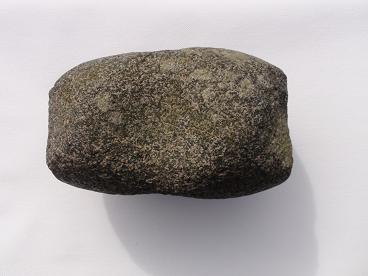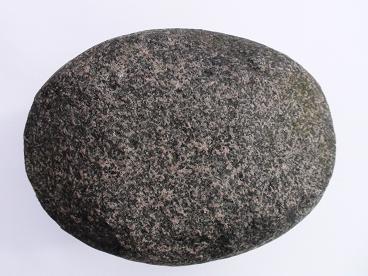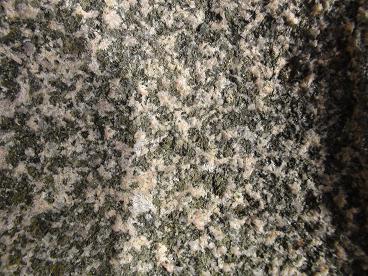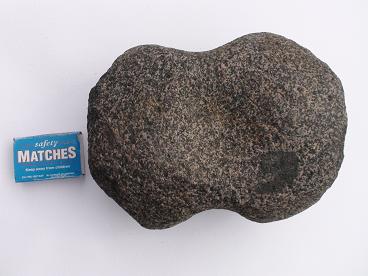Stone age, pestle, mortar and pillow, Orkney (former title: Stone age maul, Orkney)
Found: Unique Stone Age Pillow and Pestle, Orkney
This unique just over 10 pounds weighing hand-maul, hammerstone or pestle, (now also seen as possible pillow), whatever it is, came out of my dry-stone garden-wall in Orkney. Dry-stone mason George B. is my witness that it was definitely coming from the wall he is moving in my garden. The wall was most probably built just after WWII, from stones on the beach and most stones probably ‘robbed’ from the ‘forgotten’ megalithic chamber ruin halfway from my house to the beach, less than half a mile away. How this obvious artefact ever ended up in my garden-wall is still a kind of mystery although George told me dry-stone masons like him tend to leave a special mark in a wall which the next mason or anybody else in the know will find when they take it apart for repair and put it back in again.
This way he ever found a hundred year old bottle of whiskey in a wall. He took it to Orkney’s Highland Park distillery, where they brew high quality whiskey, still with local peat, and they confirmed its age. Highland Park’s ’18 year old’ is, according to connoisseurs, the ‘best whiskey in the world’, so the bottle was worth a fortune. “What are you going to do with it?” they asked. “Put it back in again” George answered, “I always put back in the wall what I get out”. “But won’t you drink it then?”, they tried. “I don’t like whiskey”, George, originally a Londoner, retorted. So somewhere in Orkney a priceless bottle of whiskey is hidden in a garden wall of which even the owner is not aware, only George knows……
Still, what could have happened is that the original stone-mason saw that it was a special stone, but archaeology was on nobody’s mind at the time yet in Orkney, so he hid it in the wall as was the old custom. George had obviously not noticed it when taking apart the wall. Or did he and had he kept it for the last part to go in … I wonder.
Anyway I saved it from oblivion and hope to return it one day to where it belongs. In Orkney.
Symmetry and indentations
What made me immediately recognize the stone, lying between the last stones to be put back in the new wall, as an artifact, were its symmetry and the neat circular indentations in the side of the stone, which right-away reminded me of the stone cubes found at the excavations at the Ness of Brodgar a year or two ago of which one (the biggest) had exactly the same kind of indentations on several of its 6 sides and the same smooth roundness; circular indentations were also obvious in another cube found at that time ( see photos below). This present stone-age artifact is much bigger and heavier though, but its likeness proves for me it is from the Stone Age since there is no doubt about the cubes from the Ness being Stone Age artifacts. It is unique because nothing like it can be found on the pictures of mauls or pestles on the Internet.
An archaeologist in Orkney told me, it was nothing special, whereas my old friend Michael Gibbons, well known archaeologist in Ireland, was delighted when I showed it to him; he couldn’t stop saying how ‘lovely’ it was and offered me a 3/4 stone-age mortar to swap. The kind of mortar that would have been suitable for this kind of pestle! I declined. Another archaeologist said I should be careful it not be stolen by some archaeologist! Well, that must be special then.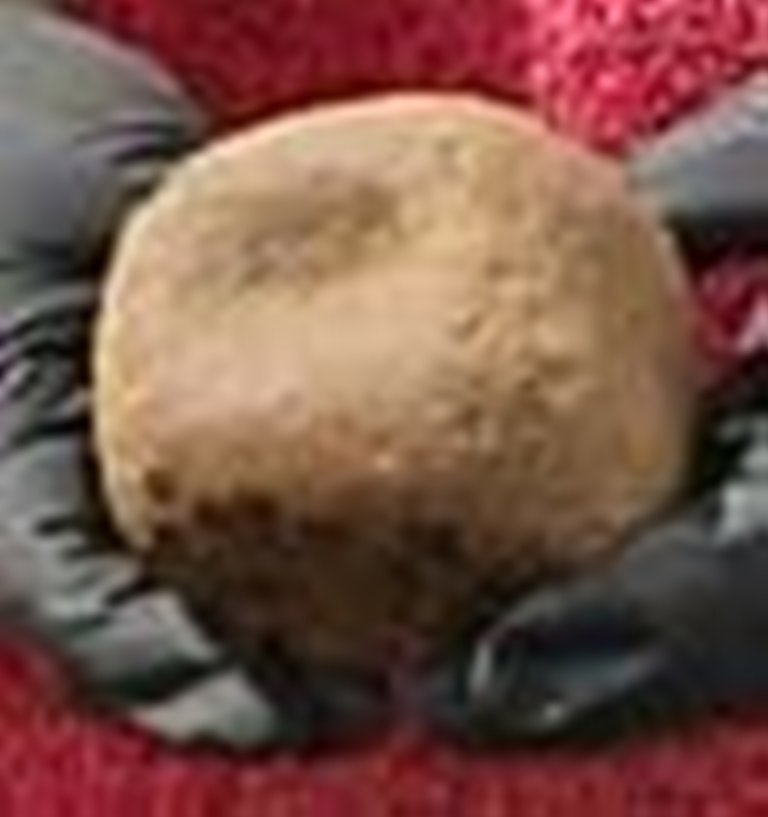
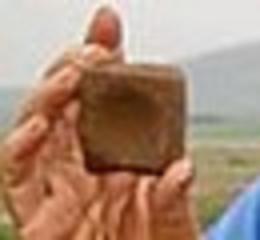
Dimensions The ‘pestle’ is length-wise two sided symmetrical and measures approximately, 10-11cm thick, 13.5 cm wide and 17.5 cm long, it weighs about 4700 grams or 10.5 pounds. It is made of grey and pink spotted stone, which is most likely local pink granite.
The pillow/pestle/mortar seen from the side (above)
And from the top down, below
The tops have three flattened surfaces
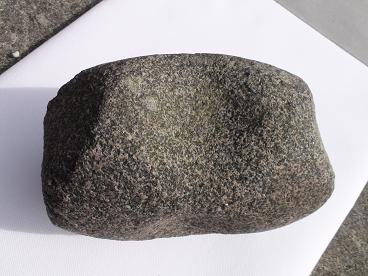
It is a very regular piece of work and beautifully made given the hardness of the rock and the possible uses of it. It shows only few and rather small damages at some of the sharper edges it has. It is of a rather coarse grain, grey and pinkish, so pink granite seems most likely and this is indeed found locally, but only in a small strip 4 miles long and 1 mile wide, near Stromness, close to Marwick Bay where I lived.
For granite it is described as fine-grained. So, fine-grained pink Stromness granite. There is a part which seems a restoration with cement, but on closer look it shows a dense pinkish ring around the anomaly.
What only struck me much later was the difference in smoothness between the rough flattened ‘angular’ ends and the big smooth sides with hollows. To the touch these sides seem pleasant to hold for hands but could also result from grinding, although that seems not ‘handy’, unless with both hands. Still the indentation could have helped to slow the feed of the grain under the pestle, and be used as a mortar itself. The round side indentations are similar to those of the cubes, which were rather definitely not used for grinding, but very smooth and really precise cubes, mind you. The cubes I think were ‘inkpots’ for whatever ink they used to whatever ends they served. The enigma of its use remains.
Recent intermezzo 23/03/2025 the pillow
I can now say that I think I have found another important use of the artifact : as a ‘cushion block’. When it flashed through my mind and I tried to come to terms with the formidable insight, I tried it out on the wooden floor. It’s perfect. It’s high so it really brings your head horizontal on your side, 4 heights, that’s comfortable, all the soft polished roundings make sense now. It is your cheekbone getting into the indentation that makes for the most comfortable side posture for your head, pressure goes to the temples, really ingenious, it also wobbles in all positions which is comfortable, less resistance when moving the head in sleep, but it is not easy to find the optimum angle for the hole. The ear also fits in comfortably. Then when you lie down with your upper neck in the broad side indentation, 2 levels, its comfortable keeping your neck in a just right angle in which by opening your eyes, immediately the scene is overseen from the horizon of your belly. The ‘wakeful’ sleep. Perfect when out in the ‘bush’ or under ‘strife’. Also to make micro or macro palissades by driving in piles that shelters perhaps one body only, as it spends the night in territory of dangerous night animals. This multifunctional tool for the hunter made him a home with the most comfortable sleep. It is very easy because of the indented shape to put a firm string around it. This would make a formidable weapon as well in the hunt as in a fight, maybe. It only adds to the multifunctionality. It is semi-domestic, but carried in the hunt, maybe.
I couldn’t think of a more elucidating artifact to exhibit the multifunctionality of tools (as of buildings) than this puzzle from at least the Neolithic, the Late Stone Age. It is hard to be found so undamaged given its most probable use. (as a two-hands flat pestle with a hollow to ‘ease the grinding’ in a wide pestle, like Michael has).
I’ve called the artifact a maul a first because I could not think of anything better, although I couldn’t figure out how it would be attached to a handle with this very specific shape, my problem was its size and weight, which is heavy for one hand. It can be held in the hand though, so maybe it is a hand hammer stone as well, after all, but for my (rather small) hand it is just a bit too big to be comfortable, but the design gives a bigger male hand possibly a firm grip, it is actually fitting many sizes of hands if you know the right grip.
On second thoughts I think it was made to be used with both hands because one side is bulkier than the other, most probably grinding. Four sizes of hands get at least one good grip. So it seems not made for use by only one person, it’s a collective tool for grinding for different sizes of hands! ( ‘and of heads’, we can add now 23/3/25)
It is not like any of the pictures of mauls or pestles I could find on Internet. Compared to those it is also very sophisticated, as is usual in Orkney, and made of a really hard type of igneous rock, so the nearby pink local granite is the most likely source of this telling treasure, coming from the ruined chamber at Marwick’s lagoon. A perfect sheltered fishing place.
I’m sure an expert on stone-age tools could be more definite about this extraordinary piece
To be continued. 23/3/25

![highlandPark18yo[1]](https://goudryan.com/wp-content/uploads/2013/04/highlandPark18yo1-150x150.jpg)
